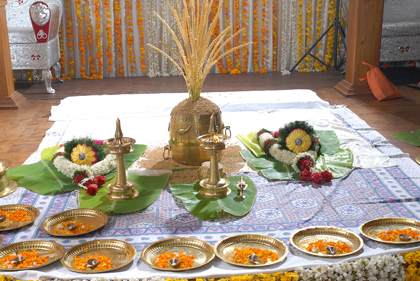The Simple Elegant Kerala Hindu Wedding
 When we say “Kerala”, I’m sure the first thing that comes to any mind is “God’s own country”. As you continue to ponder, your imagination carries you to the greenery, the backwaters, picturesque coconut trees and a land rich in culture and tradition. This is the land that keeps up to every bit of the ancient tradition, thus maintaining the rich cultural essence of this beautiful state.
When we say “Kerala”, I’m sure the first thing that comes to any mind is “God’s own country”. As you continue to ponder, your imagination carries you to the greenery, the backwaters, picturesque coconut trees and a land rich in culture and tradition. This is the land that keeps up to every bit of the ancient tradition, thus maintaining the rich cultural essence of this beautiful state.
As in all Hindu marriages, the “matching of horoscopes” plays a cardinal role in decision making. An astrologer confirms the matching of both the horoscopes. After the star and horoscope matching is completed, the elders of the boy’s family take the opportunity to go ahead and approach the girl’s family for further wedding talks. Once the girl and the boy’s family approve of the match, the girl and her family are invited over to the boy’s place (Virunnu). At this visit, a tentative engagement date may be decided on.
The engagement: (Nishchyam)
As other cultures, the wedding preparation begins with the engagement ceremony. Different communities in Kerala, depending on their geographical diversity have their own engagement ceremonies. Usually the engagement takes place in the girl’s house.There is a ceremony where the bride and groom exchange rings (mothiram maral) Both the families get together and an astrologer is called to choose auspicious dates from a Panchangam ( A book that contains auspicious times and dates). Unlike other south Indian weddings, Thambalams (plates containing fruits, nuts and sweets) need not be exchanged. After this, a grand Sadya (traditional meal) is served.
Blessing ceremony (Thaleluarieduva):
Thala (head), Ari (rice), Eduva (receiving blessings)
This is a unique custom that takes place both in the to-be bride as well as the to-be bridegroom’s side. This can take place either on the day of the wedding or a day before the wedding. This decision is made by asking priests to calculate the Muhurtham (auspicious time). The girl and boy receive blessings from all the elders in their families where raw rice is poured over their heads and the couple, in turn touch their feet to receive their blessings. It is interesting to note that even older cousins can do the honours by pouring raw rice over the girl and boy’s head.
Wedding wear:
The wedding attire of this place is totally unique to this land and is not worn anywhere else in the country. This is how unique it is. The brides usually wear a traditional Kasavu Saree and the boy’s wear a Shirt and Mundu.
The ceremony:
Usually the people in Kerala love to decorate the stage with lamps and flowers. Normally, there is no fire or homam and even the priest, is not called unless the function occurs in the temple. A vessel made of brass and copper, called the para is filled with rice grains and husks (nellu). The girl is brought into the hall accompanied by her aunts, sisters and other close female relatives, each of them carrying lit lamps in their hands. The boy arrives in the the same way with people from his side surrounding him and accompanying him as he walks in for the ceremony.
Once they are seated, the boy’s parents bring a thali (mangalsutra), which is a simple gold chain with a leaf like pendant, in Kerala tradition. The boy ties it around the girl’s neck and his sisters help in the process. After that, garlands are exchanged. It is here when the father of the bride holds her hand and gives it to the bride groom. This symbolizes handing over the girl to the boy’s family. After holding the bride’s hand, the groom with the bride close behind him, go around the stage thrice, thus denoting the end of the wedding. Finally, the couple receives blessings from the elders of the family. As thanks giving bride and groom separately give Dhakshina (token amount in reverence) to the Poojari (priest) in betel leaves. The amount of Dhakshina should be entrusted to the couple by their respective brother-in-laws as a custom. After this, the feast of the Sadya is opened for all to partake of.
Post ceremonial events:
After the meal is over, the groom and his family take the bride to his home. At the groom’s house both bride and groom are received on similar lines as was witnessed at bride’s house. The bride enters the house of groom by holding a Nilavilakku. She has to put her right leg first into the house. Dowry is a tradition among all sections of society in Kerala. Gold ornaments are a major part of dowry. Other than that a car, and home appliances are also given to the newly wed couple, more to keep up the tradition than to actually follow it.
Kerala weddings are known for their charm and elegance with a lot of customs and traditions close to the heart of every inhabitant of God’s own country.
January 24, 2016
1840 Views